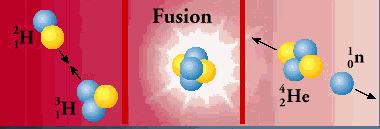 How does the fusion in the Sun work? The Sun is very hot. In fact, it is so hot that it provides enough warmth and light to our planet. How did it become hot in the first place? The Sun is made up of light gasses, specifically hydrogen. What happens to hydrogen inside its core that makes it extremely hot? This is where fusion comes in. Knowing the part that fusion plays in the Sun’s current state right may also bright about light to an immense source of inexhaustible source of energy. Scientists are studying the mechanism of fusion because it might just be the answer to the Earth’s increasing need of energy.
How does the fusion in the Sun work? The Sun is very hot. In fact, it is so hot that it provides enough warmth and light to our planet. How did it become hot in the first place? The Sun is made up of light gasses, specifically hydrogen. What happens to hydrogen inside its core that makes it extremely hot? This is where fusion comes in. Knowing the part that fusion plays in the Sun’s current state right may also bright about light to an immense source of inexhaustible source of energy. Scientists are studying the mechanism of fusion because it might just be the answer to the Earth’s increasing need of energy.
The fusion in the Sun starts with hydrogen atoms. Helium is created once two of these hydrogen atoms combine. The process of the two hydrogen atoms combining or fusing together releases an incredible amount of energy. Why do these two atoms fuse together? It is a combination of gravity, density and temperature that makes the fusion possible. This is just a preview of it. In fact the actual mechanism itself is much more complicated.
Deuterons are formed when 2 pairs of protons fuse. Then this fuses again with another proton that results to helium-3. If two helium-3 combine or fuse, a beryllium-6 is achieved. This final result unfortunately is so unstable that it split up into a helium-4 and 2 protons. The process thus results in 2 neurons, 2 positrons and gamma rays. This complicated yet sophisticated process is what makes up the mechanism of the fusion in the Sun. It is because of this process that the Sun is able to provide the warmth and the light that we need in order to survive. This is the same mechanism that is being studied and developed in order to develop a man made source of infinite energy in the future.
